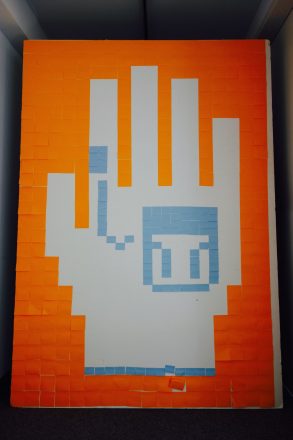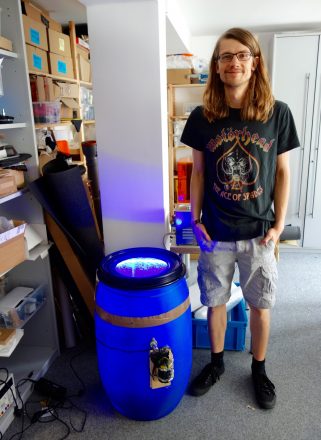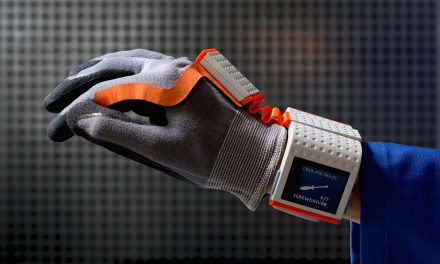Mark just might become the most loyal companion for many people working in industrial companies. Why? Because Mark is the first intelligent glove to have hit the market for Industry 4.0. For us, that is reason enough to meet up and talk with the brains behind Mark, namely the founders of ProGlove.
Times are exciting for ProGlove: They recently moved into their new office space near the Ostbahnhof train station, the team is constantly growing and becoming more international, and – last but certainly not least – the company’s very first product, the intelligent Mark glove, just officially launched. The pre-series has already been subject to real-life use and testing by clients including BMW and Skoda.

What can Mark do?
By triggering a button with the thumb, Mark is able to scan a barcode and give direct visual, audio and tactile feedback to the person wearing it. The glove immediately lets the wearer know if they have correctly completed each individual step. Having to look at a monitor becomes obsolete, as does the need for an external scanning device.
The ProGlove system comprises a central computer unit and a work glove with integrated electronics. Integrating it into existing systems is not very difficult, according to ProGlove.
“The goal was to make the glove intelligent”
But let’s start at the beginning. How did the ProGlove founders – Thomas Kirchner, Paul Günther, Jonas Girardet and Alexander Grots – even come up with the idea of developing wearables for industrial use?
Two factors played a major role, both of which inspired them to create an intelligent glove. One was the “Intel Make it Wearable” competition in Silicon Valley. The challenge awards a prize amounting to half a million dollars, and the founders wanted to participate. While they were pondering which branch they wanted to develop wearables for, Paul’s knowledge from the industry also played an important role. During his studies, he led guided tours for BMW, where he gathered his first impressions of assembly line work. He noticed that making what seemed like a small improvement to cycle time could make an enormous impact. He also noted that most of the workers typically wore work shoes, aprons and, of course, gloves. So why not utilize the clothing worn by the worker to optimize the process? It did not take long to decide on gloves, and those gloves had to become just one thing: intelligent. Paul explained why:
“If I can optimize just one little step in the process, then that is a powerful lever. As a worker, I do not make a particular movement just once, but instead make it maybe 500 or 1,000 times each day.”
And so the idea was born and the first prototype was developed as part of the Intel Challenge. Sure enough, the team took third place on the winner’s podium along with 150,000 dollars. The positive response from the press and industry that followed prompted the quartet to follow up on the idea. ProGlove came to be.
That made it the first intelligent glove, albeit in a somewhat simplified version. During the first few months and while testing over 70 prototypes, they noticed that some of the initial features were not actually necessary.

As a result, the first product, Mark, primarily focuses on speed as a factor in manufacturing and logistics processes. How it works: Using the barcode scanner that is attached to the ProGlove, a worker is able to directly scan each individual component that is to be installed. This eliminates having to pick up a scanner – which in turn saves approx. 3 seconds in each scanning step. If you assume that about 1,000 scanning steps are carried out for each car, you can just imagine how great the potential is for saving time – and subsequently money.
Mark has even more benefits to offer. Here the keyword is quality, since the glove can verify that the proper components have been installed. It also documents where each component is installed, which leads to the third keyword: documentation. The person wearing the glove also benefits from the intelligent piece of workwear. Hands-free work makes work processes more ergonomic.
So where can the intelligent glove be put to use? Thomas pointed out:
“We started with the automotive industry because that is where we saw the greatest demand. Since then, we have branched out to quite a few other industries, such as logistics. Again, the objective is fast and ergonomic scanning.”
Many other areas of application are imaginable for the future, for instance in the care sector. Their grand vision: Every glove that is used professionally should become intelligent!
“If I do not feel supported as a founder in Munich, then I am just too stupid for the job”
ProGlove briefly considered leaving Munich as their company headquarters and moving to the US. However, it was not because the four founders felt that they were not in good hands in Munich. It was quite the opposite, as Thomas explained:
“If I do not feel supported as a founder in Munich, then I am just too stupid for the job. There are so many offers. As an example, we took advantage of everything Munich has to offer when it comes to entrepreneurship centers, such as the UnternehmerTUM, SCE (Strascheg Center for Entrepreneurship), the LMU EC (Ludwig-Maximilians-University of Munich Entrepreneurship Center) and Techfounders.”

When it comes to financing, however, things are a bit more difficult for hardware startups in Munich, and in fact in Germany in general. This is because the German financing scene feels pretty comfortable in the software field at the moment and is avoiding the more risky hardware area — at least, that is how the ProGlove founders feel:
“Hardware simply requires more money, because the development cycles are significantly longer. You also have to invest more in working with the industry. This particular clientele requires a lot more convincing and usually pays later.”
Investors look at things differently in the US. The readiness to take a financial risk is much higher in America. Faith in German engineering is also still strong abroad despite several scandals, so ProGlove was able to land a deal with two American investors, namely with Intel Capital and GettyLab. The third party in the investor round is Bayern Kapital. In total, the Munich startup was able to bring in 2.2 million US dollars in the first financing round. The four also decided to stay in Munich. It came down to the manufacturing conditions being significantly better than in the States.
So what is the plan?
With Mark on the market, what is ProGlove planning to do next?
“Since we have VC invested in the company, the major focus is now on scaling. We have to bring in revenue and want to serve as many customers as possible. At the same time, we have started to work on our second product.”

Product number two is the intelligent glove Katharina, which will also include an integrated display.
Making it on the American and Asian markets is also on the agenda. That will make additional licenses necessary, since Mark is currently only approved for the European market.
The next financing round is set to take place in mid-2017. Since their valuation will be based on revenue, the goal until then will be to make Mark every worker’s best friend!



